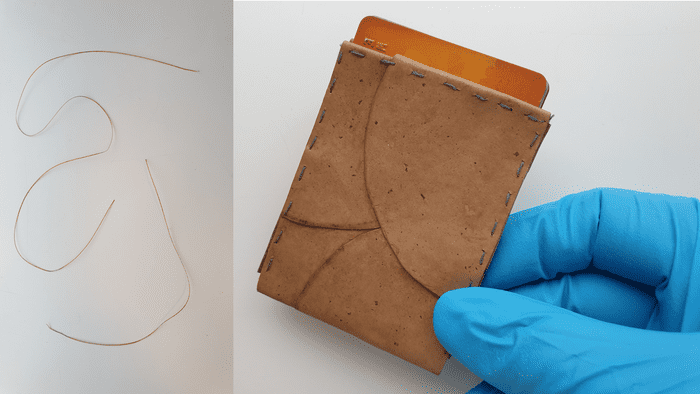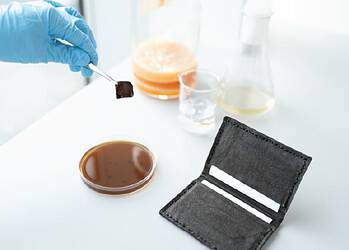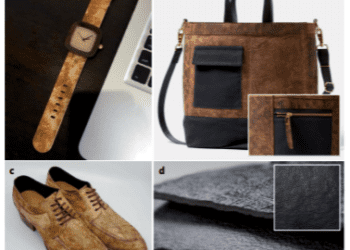
When we think of environmental impacts, the fashion industry is not the first sector that typically comes to mind — but maybe it should. Textiles rely heavily on petrochemical products that come from the same fossil fuel industry that’s driving climate change — which is why it’s more important than ever to find a way forward, starting with the textiles we currently use.
In a new study, a team of researchers has found how to harness the power of fungi to convert food waste into sustainable, paper and cotton substitutes. It takes less time to produce than existing substitutes already on the market and is 100% biobased. A win-win idea that could offer a potential solution for fashion’s environmental footprint.
“We hope they can replace cotton or synthetic fibers and animal leather, which can have negative environmental and ethical aspects,” Ajram Zamani, the project’s principal investigator, said in a statement. “In developing our process, we have been careful not to use toxic chemicals or anything that could harm the environment.”
The footprint of the fashion industry
The fashion industry is a big player modern economy, with an overall value of over $2.5 trillion and employing 75 million people worldwide. The sector has seen big growth over the past decades, but that has come with a cost. Fashion production accounts for 10% of humanity’s carbon emissions, with 85% of all textiles going to the dump every year.
More clothes are being produced than ever, as fast fashion pushes us to go through clothes at a frantic pace. Estimates suggest the number of clothing items produced each year has doubled since 2000, and only a fraction of that gets recycled. This has raised a lot of criticism against fashion brands, on top of usually dangerous conditions for their workers. This is where the fungi could come into play.

Polyester, a form of plastic derived from oil, has largely overtaken cotton as the main driver of textile production. This has come with a wide array of environmental consequences, including greenhouse gas emissions and air, soil, and groundwater pollution from microplastics and synthetic dyes used in clothes manufacturing.
Other materials share similar concerns, such as leather. We know it as a strong, durable, long-lasting material but it comes with a long list of environmental problems, starting with tanning. The most common tanning method is based on chromium, a heavy metal that in large amounts can be dangerous to humans and the environment. The leather industry also requires the slaughter of animals, which can raise ethical (and environmental) concerns.
With this in mind, Zamani and a team of researchers in Sweden set out to find a way forward, creating sustainable materials derived from fungi. They are not the first ones to produce a fungal alternative. However, they claim their product can match real leather and reach a production rate that could realistically meet market demands.
The production processes
A full study is not published yet and information is still somewhat scarce, but Zamani explains that most fungal materials are made from harvested mushrooms or from fungus that grow in a layer on top of food waste or sawdust. This requires a long time to produce enough fungal materials. Meanwhile, the fungus she uses is submerged in water and takes only a couple of days to grow.
Also, some of the fungi-based leather currently in the market uses environmentally-harmful coatings or layers made of synthetic polymers derived from petroleum, which means more greenhouse gas emissions. This contrasts with the approach used by Zamani and her team, as they only used natural materials – making it biodegradable and sustainable.
The researchers worked with a specific fungal strain, Rhizopus delemar, commonly found on decaying food. To feed it, they collected unsold supermarket bread, which they dried and ground into breadcrumbs. The fungus fed on the bread and produced very small natural fibers made of chitin and chitosan that accumulated in its cell walls.
Two days after feeding, the team collected the cells and removed byproducts that could potentially be used in food or feed, such as proteins and lipids. However, what they were actually after was a jelly-like residue – a sort of goop made of the fibrous cell walls. This was spun into yarn, which can be used in clothing and even sutures.
The researchers carried out a set of trial-and-error tests and have now come up with multiple layers of these fungal sheets. These are treated with tree-based tannings to make them softer and alkalis to give them strength. Finally, flexibility and strength are improved by a treatment based on glycerol and bio-based binder, producing a material that mimics real animal leather.
However, this isn’t the end of the road. The team is still working on further improving their fungal products. They recently started testing other types of food waste to grow fungi, including fruits and vegetables. They are particularly interested in the pulp left over after fruit juice is pressed from fruit. Instead of throwing it away, they might as well use it for fungi.
The study was presented at a meeting of the American Chemical Society (ACS) and was not yet peer reviewed.






